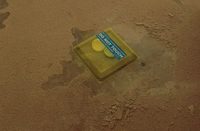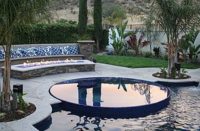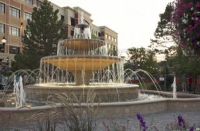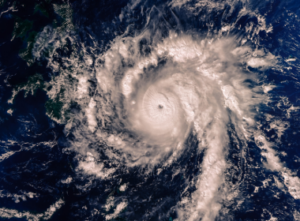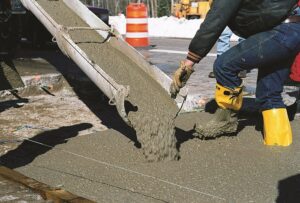Outdoor kitchens are becoming more and more popular, and special considerations must be made in order to ensure concrete’s durability, longevity and aesthetics in these applications.
Let’s face it, it’s brutal out there. The sun bakes and fades, water freezes and thaws, and rain soaks and saturates. Concrete exposed to the elements can start deteriorating quickly if it’s not made correctly. Colors can fade, sealers can peel, polished surfaces can dull or etch, and the basic structure can degrade and literally fall apart if things aren’t done right. So let’s talk about what it takes to make good-looking outdoor kitchen concrete that can stand up to what Mother Nature throws at it.
Concrete countertop mix design
Good concreting practices are essential to being successful. If the concrete’s poorly made or insufficiently cured, or if the wrong mix is used, there’s a good chance costly problems will crop up.
From the start, the concrete countertop mix design must be tailored to meet the challenges of its environment. Fortunately, most concrete is meant to be used outside, so this shouldn’t be a big challenge. We’re looking for strong concrete, but we also want durable concrete that is dense and has little porosity.
Conventional concrete that has at least six to seven sacks of cement per cubic yard and has good aggregate gradation is a good start. Fortunately, most concrete used for concrete countertops is much richer than this. These characteristics help reduce shrinkage cracks, curling and freeze-thaw degradation.
Low water-to-cement (w/c) ratios help reduce porosity, reduce shrinkage, improve freeze-thaw resistance and, of course, yield stronger concrete. Water-to-cement ratios should be kept at or below 0.40. Lower is always better, but strike a balance between workability, cost and the benefits of a low w/c. Very low w/c (less than 0.30) will make very strong concrete, but only certain mix designs yield easy-to-work-with concrete. For precast work I favor a w/c of about 0.32. For cast-in-place I recommend a slightly higher ratio of about 0.37, since more water is necessary in these mixes because the superplasticizers make finishing more difficult. Generally, mid-range water reducers are used for troweled cast-in-place finishes where the stickiness and persistence of superplasticizers isn’t wanted.
Besides the basics of aggregates, cement and water, pozzolans and admixtures play an important role, especially when that concrete is exposed to the elements. Pozzolans consume calcium hydroxide, a prime efflorescence-generating compound that’s produced when cement hydrates. Besides reducing efflorescence, some pozzolans can enhance the concrete’s workability and increase the strength of the concrete. In the long term, pozzolans help create a strong, dense cement matrix, yielding low-porosity concrete that is more resistant to shrinkage and freeze-thaw. Consider using a high-reactivity pozzolan such as powdered glass (Bottle Pozz and Vitro Minerals’ VCAS are two brands) or metakaolin. These manufactured pozzolans will give higher early strengths and can significantly reduce or eliminate efflorescence. Powdered-glass pozzolans enhance workability and fluidity, while metakaolin makes concrete creamy and sticky, good for applications requiring stiffer concrete.
Freeze-thaw resistance
For climates where winter involves freezing temperatures, air-entraining agents are a must. These admixtures generate microscopic air bubbles that are evenly distributed throughout the cement paste. If the concrete is saturated with water when it freezes, the ice crystals that form expand inside the concrete. Repeated freezing and thawing can take their toll on concrete that is not air-entrained.
The closely spaced, microscopic bubbles entrained in the cement paste give the ice someplace to expand into, saving the concrete from gradual disintegration.
Generally, entrained-air content of 4 to 7 percent is sufficient for protection from mild (4 percent) to severe (7 percent) conditions.
What to color with
Concrete that’s colored shouldn’t fade or change color over time. The common ways to color concrete each have different considerations regarding outdoor use.
Always use integral pigments designed for concrete or masonry mortar, and select pigments that are UV stable. Iron oxides and carbon black are stable in UV environments, but not all synthetic pigments are. Consult with your pigment supplier.
Most broadcast color hardeners contain integral pigments, and they are also used in overlays and skimcoats.
Acid stains are another way of coloring concrete. Acid stains aren’t affected by the sun, but some colors (blues and greens) can turn black and blotchy from moisture and oxidation. Remember to neutralize with ammonia after use, and then scrub and rinse well to remove the residue. Sealer failures are commonly linked to poor surface cleaning, and this issue can be magnified in outdoor settings.
Acrylic stains are inert pigments in an acrylic carrier. These don’t react like acid stains – there’s no acid in them. They are simply applied to the concrete before it’s sealed. Make sure the concrete is clean and dry before use, and let the pigmented stains dry thoroughly before sealing.
Finally, dyes can be used too, but most dyes are not suitable for use outside. Some companies have developed dyes that remain vibrant outside, so make sure that if you dye, you use one of those.
Handling heat
Color also impacts your client when it comes to managing heat. Concrete warms up in the sun. If the concrete is dark-colored, the concrete will get hot. Lighter colors reflect heat and light, while darker colors absorb the heat from the sun. I once took the temperatures of two pieces of concrete left out in the hot North Carolina summer sun. The dark brown acid-stained concrete was hotter than 120 F, too hot to touch even for a few seconds. The same concrete with a much lighter color was a relatively cool 85 F. While not cold, it was quite comfortable to touch. A rich dark brown or black bar top may look great but won’t get much use outside if it’s too hot to sit at.
Daily heating and cooling from the sun affects your concrete too. Concrete expands when it heats up and contracts when it cools off. As with all other forms of outdoor concrete, joints and seams in tops play an important role in controlling cracks and managing slab movement.
Outdoor temperature variations are much greater than indoor variations, so accounting for thermal issues becomes very important. Interior home temperatures generally only vary by 5 to 10 degrees, since most homes are air-conditioned in the summer and heated in the winter. Outdoor temperatures can vary by more than 10 times that range. In some areas in the summer, daytime surface temperatures can reach 120 F in direct sunlight while nighttime temperatures can drop to 50 F.
Heat causes concrete to expand, and cooling the concrete down contracts it, making it shorter. Just like with slabs-on-grade, joints allow for movement and help control (and even prevent) cracks.
Slabs allowed to move freely are less likely to crack. This is the approach used for commercial GFRC building panels. GFRC (glass-fiber reinforced concrete) actually expands and contracts at twice the rate that conventional concrete does. Large panels up to 30 feet long are mounted so that thermal and moisture movement can happen without stressing the concrete.
The best type of sealer
Finally, choosing the right sealer is paramount to providing your client with outdoor concrete countertops that perform well and look great year after year. Many decorative concrete sealers are designed for outdoor use, but beware of finishes that either don’t stand up to UV exposure or must be reapplied (unless that’s part of a service package you provide).
Most epoxy finishes will yellow and fail from exterior use. Many acrylic finishes look great, but some wear off or actually break down from the rigors of the outdoors.
Unlike interior concrete countertops, those used outside get rained on and are generally wetter for longer periods of time. Issues with vapor pressure start to come into play, especially with sealed concrete that’s submerged or very frequently wet.
If you’re looking to get excellent stain and acid protection, consider an exterior-grade urethane coating designed for concrete. There are a few on the market that will stand up well year after year in outdoor settings.
If you prefer a more natural bare-concrete feel, use a good densifier followed by a repellant. This combination treats the concrete rather than coating it. The advantage is that there is nothing on the surface to peel or discolor. Maintenance is very simple, with reapplication of the repellant required on approximately an annual basis. The only downside to this type of finish is that the concrete has no acid protection. Keep in mind that acid rain occurs in many areas. Oil may stain the concrete as well, which may be a consideration with outdoor bar tops.
